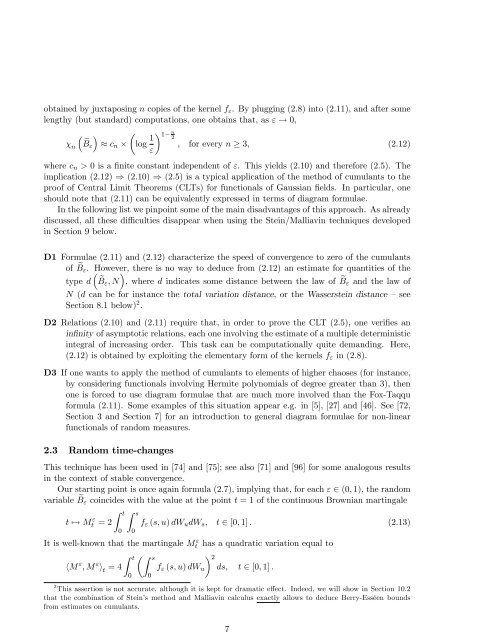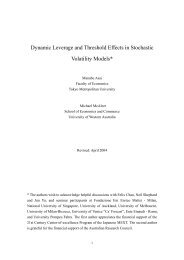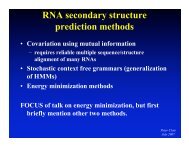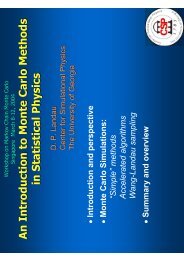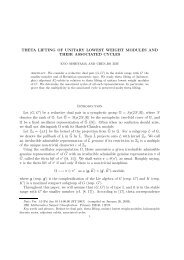Stein's method, Malliavin calculus and infinite-dimensional Gaussian
Stein's method, Malliavin calculus and infinite-dimensional Gaussian
Stein's method, Malliavin calculus and infinite-dimensional Gaussian
Create successful ePaper yourself
Turn your PDF publications into a flip-book with our unique Google optimized e-Paper software.
obtained by juxtaposing n copies of the kernel f " . By plugging (2.8) into (2.11), <strong>and</strong> after some<br />
lengthy (but st<strong>and</strong>ard) computations, one obtains that, as " ! 0,<br />
<br />
eB" n c n log 1 1<br />
n<br />
2<br />
, for every n 3, (2.12)<br />
"<br />
where c n > 0 is a …nite constant independent of ". This yields (2.10) <strong>and</strong> therefore (2.5). The<br />
implication (2.12) ) (2.10) ) (2.5) is a typical application of the <strong>method</strong> of cumulants to the<br />
proof of Central Limit Theorems (CLTs) for functionals of <strong>Gaussian</strong> …elds. In particular, one<br />
should note that (2.11) can be equivalently expressed in terms of diagram formulae.<br />
In the following list we pinpoint some of the main disadvantages of this approach. As already<br />
discussed, all these di¢ culties disappear when using the Stein/<strong>Malliavin</strong> techniques developed<br />
in Section 9 below.<br />
D1 Formulae (2.11) <strong>and</strong> (2.12) characterize the speed of convergence to zero of the cumulants<br />
of B e " . However, there is no way to deduce from (2.12) an estimate for quantities of the<br />
type d eB" ; N , where d indicates some distance between the law of B" e <strong>and</strong> the law of<br />
N (d can be for instance the total variation distance, or the Wasserstein distance – see<br />
Section 8.1 below) 2 .<br />
D2 Relations (2.10) <strong>and</strong> (2.11) require that, in order to prove the CLT (2.5), one veri…es an<br />
in…nity of asymptotic relations, each one involving the estimate of a multiple deterministic<br />
integral of increasing order. This task can be computationally quite dem<strong>and</strong>ing. Here,<br />
(2.12) is obtained by exploiting the elementary form of the kernels f " in (2.8).<br />
D3 If one wants to apply the <strong>method</strong> of cumulants to elements of higher chaoses (for instance,<br />
by considering functionals involving Hermite polynomials of degree greater than 3), then<br />
one is forced to use diagram formulae that are much more involved than the Fox-Taqqu<br />
formula (2.11). Some examples of this situation appear e.g. in [5], [27] <strong>and</strong> [46]. See [72,<br />
Section 3 <strong>and</strong> Section 7] for an introduction to general diagram formulae for non-linear<br />
functionals of r<strong>and</strong>om measures.<br />
2.3 R<strong>and</strong>om time-changes<br />
This technique has been used in [74] <strong>and</strong> [75]; see also [71] <strong>and</strong> [96] for some analogous results<br />
in the context of stable convergence.<br />
Our starting point is once again formula (2.7), implying that, for each " 2 (0; 1), the r<strong>and</strong>om<br />
variable B e " coincides with the value at the point t = 1 of the continuous Brownian martingale<br />
t 7! M " t = 2<br />
Z t Z s<br />
0<br />
0<br />
f " (s; u) dW u dW s , t 2 [0; 1] . (2.13)<br />
It is well-known that the martingale M t<br />
" has a quadratic variation equal to<br />
Z t<br />
Z s<br />
2<br />
hM " ; M " i t<br />
= 4 f " (s; u) dW u ds; t 2 [0; 1] :<br />
0<br />
0<br />
2 This assertion is not accurate, although it is kept for dramatic e¤ect. Indeed, we will show in Section 10.2<br />
that the combination of Stein’s <strong>method</strong> <strong>and</strong> <strong>Malliavin</strong> <strong>calculus</strong> exactly allows to deduce Berry-Esséen bounds<br />
from estimates on cumulants.<br />
7


